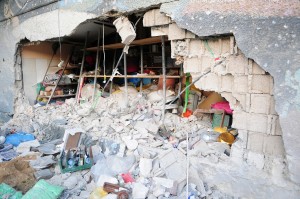BESA Center Perspectives Paper No. 189
EXECUTIVE SUMMARY: Israel’s achievements in Operation Pillar of Defense include its ability to surprise Hamas, kill its military leader, and destroy most of its strategic assets. The performance of the Iron Dome anti-missile system and Israel’s civilian defense also proved impressive. An important gain for Israel is a reduced fear of repercussions in the aftermath of an attack on Iran. The operation in Gaza also proved Israel’s determination to act forcefully in the post “Arab Spring” environment. However, the lack of a ground offensive allowed Hamas to craft a victory narrative and the potential to re-arm. The next round is only a matter of time.
Israel’s declared objectives in Operation Pillar of Defense were limited: to cripple Hamas’ military capabilities, restore its deterrence, and return quiet to the communities of the South. The operation ended with a ceasefire agreement brokered by Egypt, with US involvement. While the details of the agreement are still vague, it is possible to offer an initial assessment of the achievements and shortcomings of the operation. As history in the region indicates, the facts on the ground dictate reality more than any agreements signed on paper.
Strategic and Military Achievements
Israel’s deception tactics were useful to surprise Hamas regarding the timing and the scale of the attack. Excellent intelligence and the element of surprise enabled the destruction of most of Hamas’ strategic assets, primarily its long-range Fajr-5 rockets, and the elimination of Ahmed al-Jabari, the Hamas supreme military commander. Israel was also successful in eliminating many junior Hamas terrorists.
Israel’s defensive measures, both active and passive proved successful. Iron Dome intercepted 422 rockets that were fired into urban areas, an 88 percent success rate. The 58 rockets that did fall in these areas killed only three civilians, reflecting the disciplined behavior of the civilian population, which carefully followed the instructions issued by civil defense authorities.
During the Gaza operation the IDF took much care to limit collateral damage and reduce the number of civilian casualties in Gaza. The accuracy in hitting only military targets was a remarkable success. The civilian casualties constituted less than half of the overall number killed (about 110-130 combatants versus around 50 civilians). In comparison, the US and its allies kill five or six civilians for one combatant in Iraq and Afghanistan. The low number of civilian casualties significantly eased international pressure on Israel.
Given the changes in the Arab world following the “Arab Spring,” specifically in Egypt, there were many voices that questioned Israel’s ability to mount any military action in the region. Israel proved that when its national security is at stake it will not hesitate to act. Moreover, Egyptian President Mohamed Morsi proved pragmatic and, despite his militant rhetoric, restrained Hamas.
Israel also enjoyed American diplomatic support and backing. This support proved wrong the concerns raised by some commentators for a possible “cold shoulder” turned towards Israel by the Obama administration in its second term. The relationship between the two countries, so dear to Israel’s security, has been proven solid.
The disappointment expressed by the public for not mounting a ground offensive into Gaza signals to Hamas the level of determination of Israeli society and thus contributes to Israel’s deterrence. Israel is less casualty-sensitive than generally believed and is willing to risk the lives of its soldiers in order to protect itself.
The operation in Gaza also has ramifications for Iran, Israel’s current strategic priority. In a future military operation against Iran’s nuclear facilities, either by Israel and/or the US, Iran has promised to return in kind through its proxies Hamas and Hizballah. Iran has supplied these groups with thousands of rockets and has trained them to become launching pads for rocket attacks against Israel. By destroying the bulk of Hamas’ long-range rockets and demonstrating its ability to defend its population centers, Israel has one front less to worry about in the case of an Iranian retaliation. Israel will be freer to focus its efforts on Iran.
Operational and Long-Term Shortcomings
The timing for such an operation is critical, as it burns intelligence, and it will take time to restore full intelligence in Gaza. Employing only targeted air and naval power has serious limitations that one needs to consider. The initial attack accomplished the major gains while the most valuable targets were hit; however, as the operation continued there were less and less valuable targets to hit. The only way to keep momentum is through a ground operation.
Israel’s lack of desire to launch a ground offensive is due to the high cost of increased casualties on both sides. It also means mounting international pressure and a potential de-legitimization campaign. In addition, Israel does not want to re-assume control over Gaza and its population. However, only a large ground offensive, in which Israel must destroy the capabilities of Hamas and other terror groups, can eliminate the threat from Gaza and re-establish deterrence.
In the absence of a ground operation Israel faces two problems. First, Hamas was able to claim victory on the grounds that Israel was deterred from conducting a ground offensive. It is not clear whether Hamas believes its own story; however, this might encourage Hamas and the other terror groups to continue to provoke Israel. The second and more serious problem is that only a ground offensive that regains operational control over all or parts of Gaza can stop the smuggling of weapons into Gaza. Everything short of presence on the ground will not be effective. Under the current circumstances one should expect that in a short period, as past experience indicates, Hamas will restore and improve its operational capability. The next round is only a matter of time.
BESA Center Perspectives Papers are published through the generosity of the Greg Rosshandler Family
Click here to see a PDF version of this page
(Photo Credit: IDF)


